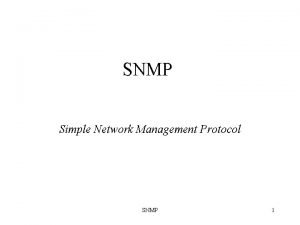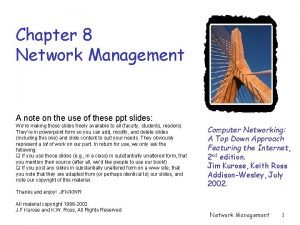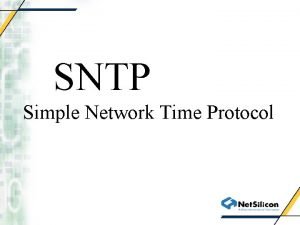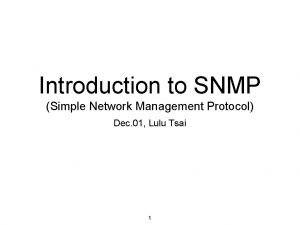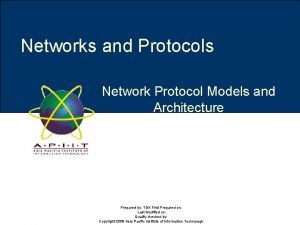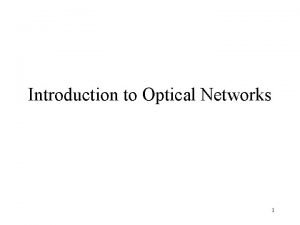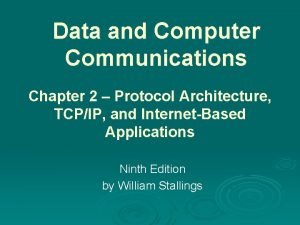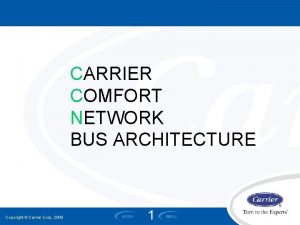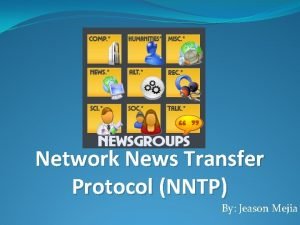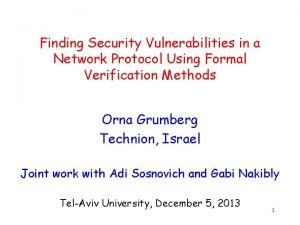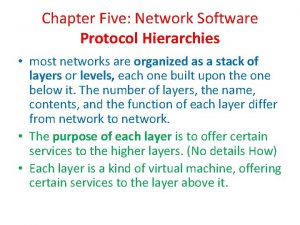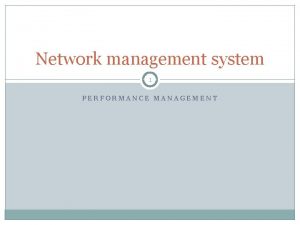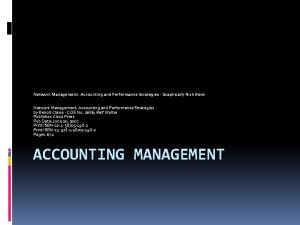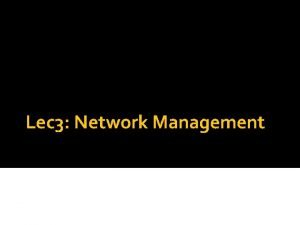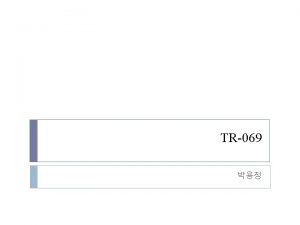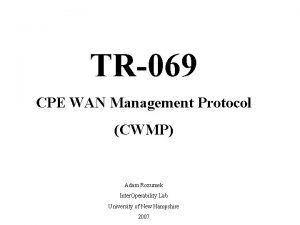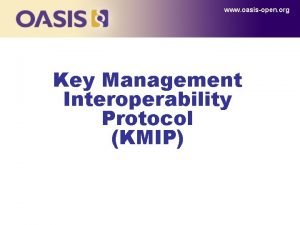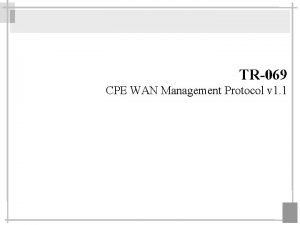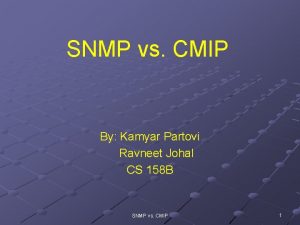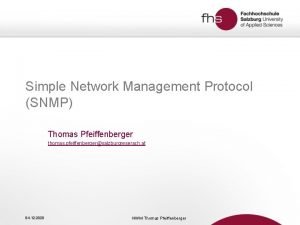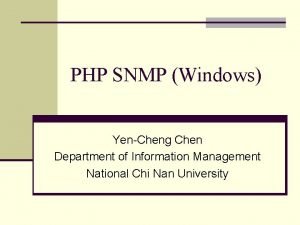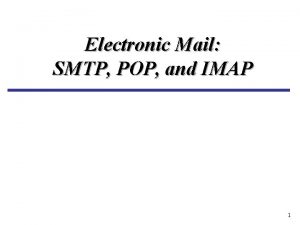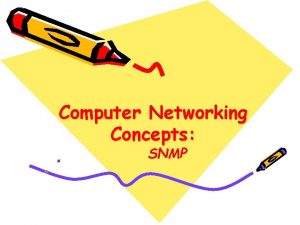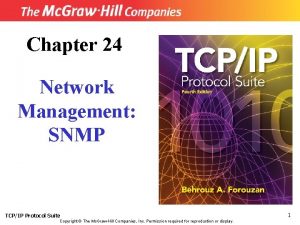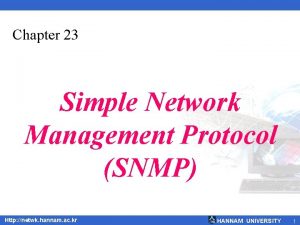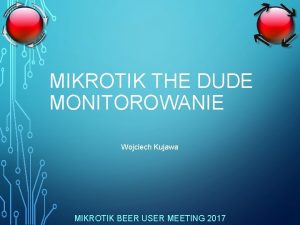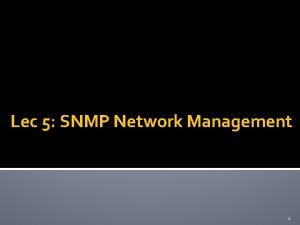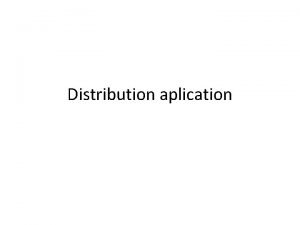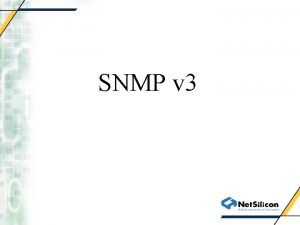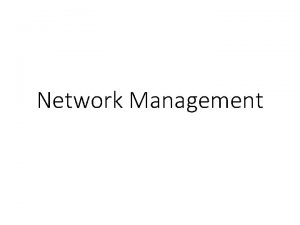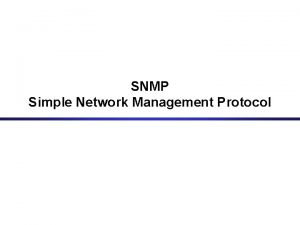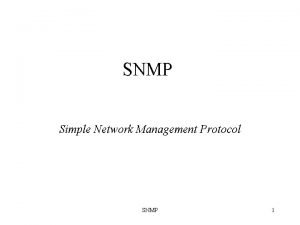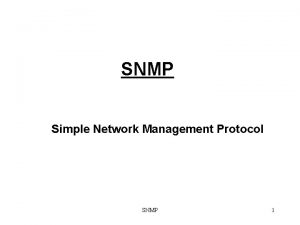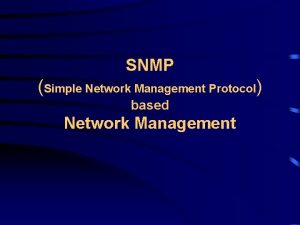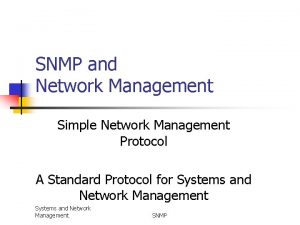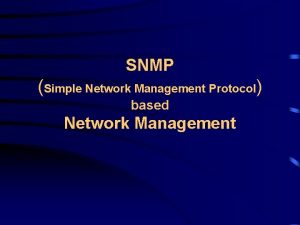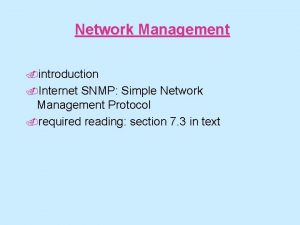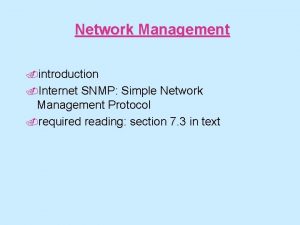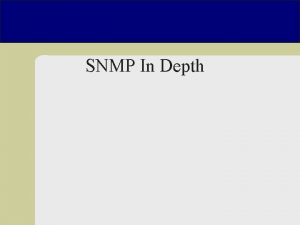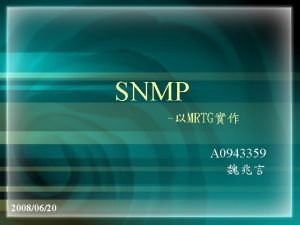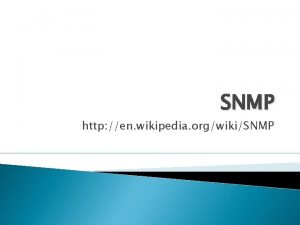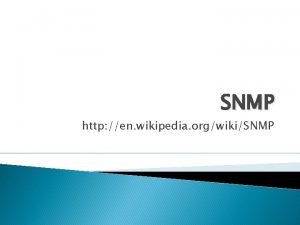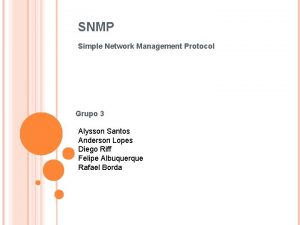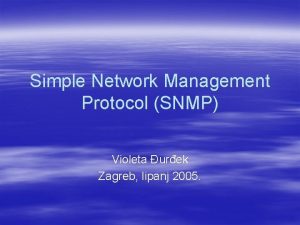SNMP Simple Network Management Protocol Introduction SNMP Simple








































- Slides: 40

SNMP – Simple Network Management Protocol

Introduction > SNMP – Simple Network Management Protocol – A set of standards for network management • • • Protocol Database structure specification Data objects – A set of standardized tools that • • Control costs of network management Across various product types > End system, bridges, routers, telecommunications, … 2

History of SNMP > In 1989 – SNMP was adopted as TCP/IP-based Internet standards > In 1991 – RMON - Remote network MONitoring • Supplement to SNMP to include management of LAN and LAN devices > In 1995 – SNMPv 2 • • Functional enhancements to SNMP on OSI-based networks – RMON 2 > In 1998 – SNMPv 3 • • Further enhancements Security capability for SNMP 3

Network Management Requirements > Fault Management – Detect, isolate, reconfigurate and repair the abnormal network environment – Problem tracking and control • Problem is truly resolved and no new ones are introduced > Accounting Management – Track the use of network resources by end user to provide • Impropriate usage tracing, charging, statistics > Configuration and Name Management – Startup, shutdown, reconfigure network component when • Upgrade, fault recovery or security checks > Performance Management – Capacity utilization, throughput, response time, bottleneck • Collect information and assess current situation > Security Management – Information protection and access control 4

Network Management System (1) > A collection of tools for – Network monitoring – Network control > These tools must be integrated – Single operator interface with powerful but user-friendly – Minimal amount of separate equipment is necessary 5

Network Management System (2) > Architecture of NMS – NMA • Operator interface – NME • • • Collect statistics Response to NMA Alert NMA when environment changing 6

Network Management Software > Architecture – Presentation SW • Unified interface and handle information overload – Network Management SW • NM applications > Admin interested tools • • Fault, security, accounting management Application element > Primitive and general-purpose NM functions • Generating alarm, summarizing data – Communication SW • Exchange management information Communication protocol stack • MIB (Management Information Base) • MIB access modules • – Database SW > Configuration and behavior > Operation parameters > Convert local MIB to standard form 7

SNMP Network Management Concept

In that time. . > Network environment is simple – ICMP is the only way to do network investigation • ping, traceroute, …. > As Internet goes popular, three approaches are proposed: – HEMS: High-level Entity Management System • Considered to be the first network management tools • SNMP was an enhanced version of the Simple Gateway Management Protocol For TCP/IP-based network management standards Supposed to be short-term solution – SGMP and SNMP • • – CMIP over TCP/IP (CMOT) • • • Common Management Information Protocol For ISO-based network management standards Supposed to be long-term solution 9

Network Management Architecture in SNMP (1) > 4 key elements – Management Station • Serve as the interface between manager and devices > Management applications > User-friendly interface > Translate manager’s requirements into actual monitoring or control operations > Database extracted from MIBs of all managed device – Management Agent • • • Respond to request from management station Change settings in MIB of managed device Asynchronously report abnormal event (Trap) – Management Information Base (MIB) • Each resource is represented as an object and MIB is a collection of objects • get, set, trap • – Network Management Protocol 10

Network Management Architecture in SNMP (2) 11

Network Management Architecture in SNMP (3) > SNMP proxy – Devices that do not support UDP/IP • ex: Bridge, Modem – Devices that do not want to add burden of SNMP agent • ex: PC, programmable controller 12

SNMP Message Information > Message Information Base (MIB) – Collection of objects and – Each object represents certain resource of managed device > Interoperability of MIB – Object that represents a particular resource should be the same cross various system • • What objects MIB-I and MIB-II – Common representation format • SMI (Structure of Management Information) 13

SNMP Message Information – SMI (1) > SMI (RFC 1155) – Structure of Management Information – Identify the data type that can be used in MIB and how resources are represented and named, including • • • MIB structure Syntax and value of each object Encoding of object value 14

SNMP Message Information – SMI (2) > MIB structure – Rooted tree • • The leaves are the actual managed objects Each object has an identifier (OBJECT IDENTIFIER) > Number with dot as delimiter • The internet node > iso -> org -> dod -> internet > object identifier of internet node: 1. 3. 6. 1 • Under internet node > directory : OSI X. 500 directory > mgmt: used for objects defined in IAB (Internet Activities Board) > experimental: used for internet experiments > private: unilaterally usage 15

SNMP Message Information – SMI (3) – MIB Tree – Define additional objects • • • Under mib-2 Under experimental Under enterprises 16

SNMP Message Information – Object Syntax (1) > Definition of object – Data type • Application-independent type (UNIVERSAL type) > integer, octetstring, null, object identifier, sequence • Application-wide types (RFC 1155) > Networkaddress -> ipaddress > counter (0 ~ 232 -1), increasing only, wrap to 0 > gauge (0 ~ 232 -1) > timeticks > opaque (encoded as OCTET STRING for transmission) > threshold – Value ranges – Relationship with other objects in MIB 17

SNMP Message Information – Object Syntax (2) > ANS. 1 – Abstract Syntax Notation One – A formal language developed by CCITT and ISO – In SNMP, we use macro to define other types used to define managed objects • • • Macro definition (template) Macro instance (particular type) Macro instance value 18

SNMP Message Information – Object Syntax (3) > OBJECT-Type macro 19

SNMP Message Information – Object Syntax (4) > Example of object definition – iso. org. dod. internet. mgmt. mib-2. tcp. Max. Conn – 1. 3. 6. 1. 2. 1. 6. 4 20

SNMP Message Information – Object Syntax (5) > 2 -D table – Two-dimensional array with scalar-valued entries – Ex: tcp. Conn. Table (RFC 1213) 21

SNMP Message Information – Object Syntax (6) 22

SNMP Message Information – Object Syntax (7) – iso (1) -> org (3) -> dod (6) -> internet (1) -> mgmt (2) • mib-2 (1) -> tcp (6) -> tcp. Conn. Table(13) 23

Standard MIBs

MIB-II (1) > RFC 1213 – MIB-I (RFC 1156) – MIB-II is a superset of MIB-I with some additional objects and groups 25

MIB-II (2) > First layer under mib-2 – 1. 3. 6. 1. 2. 1 (iso. org. dod. internet. mgmt. mib-2) – system • Overall information about the system – interfaces • – at • Information about each interface internet-to-subnet address mapping – ip, icmp, tcp, udp, egp – dot 3 • Transmission schemes and access protocol at each system interface – snmp 26

MIB-II system group > sys. Services – – – 1 2 3 4 7 physical (ex: repeater) datalink/subnetwork (ex: bridge) internet (ex: router) end-to-end (ex: IP hosts) applications (ex: mail relays) 27

MIB-II interface group (1) 28

MIB-II interface group (2) 29

MIB-II tcp group 30

MIB-II ip group 31

Simple Network Management Protocol RFC 1157

SNMP Protocol > Supported operations – get, set, trap > Simplicity vs. limitations – Not possible to change the structure of MIB by adding or – deleting object instances Access is provided only to leaf objects • Not possible to access entire table or row in single action 33

SNMP Protocol – security concern > In management environment – The management station and managed agent • • One-to-many relationship One station may manage all or a subset of target – The managed station and management station • • • One-to-may relationship Each managed agent controls its local MIB and must be able to control the use of that MIB Three aspects > Authentication service > Access policy > Proxy service 34

SNMP Protocol – communities (1) > An SNMP community – A relationship between an SNMP agent and a set of SNMP managers that defines • Authentication, access control and proxy – The managed system establishes one community for each – – combination of authentication, access control and proxy Each community has a unique “community name” Management station use certain community name in all get and set operations 35

SNMP Protocol – communities (2) > Authentication – The community name (password) > Access policy – Community profile • SNMP MIB view > A subset of MIB objects • SNMP access mode > READ-ONLY, READ-WRITE 36

UC Davis SNMP agent

UCD SNMP agent (1) > /usr/ports/net-mgmt/net-snmp – Edit Makefile • • NET_SNMP_SYS_CONTACT = tytsai@csie. nctu. edu. tw NET_SNMP_SYS_LOCATION = NCTU EC 318 – Firewall rules to restrict access to port 161 – After installation, use “snmpconf –g basic_setup” • • It will generate snmpd. conf move it to /usr/local/share/snmp 38

UCD SNMP agent (2) > snmpconf – % man snmpd – System Information Setup • Location, contact, service • SNMPv 3 or SNMPv 1 access community • Where to send the trap • Process, disk space, load, file • Let snmp agent to return information that yourself define • User/group, IP port, … – Access Control Setup – Trap Destination – Monitor Various Aspects of the Running Host – Extending the Agent – Agent Operating Mode 39

UCD SNMP agent (3) > To get various value – man snmpget, snmpgetnext, snmptable • • • % snmpget -c public -v 1 tybsd system. sys. Contact. 0 % snmpgetnext –c public –v 1 tybsd system. sys. Contact. 0 % snmptable -c public -v 1 tybsd mib-2. tcp. Conn. Table % snmpwalk –c public –v 1 tybsd system % snmpwalk -c public -v 1 tybsd iso. org. dod. internet. private. enterprises 40
 Snmpv
Snmpv Simple network management protocol ppt
Simple network management protocol ppt Snmp model in computer networks
Snmp model in computer networks Simple network time protocol
Simple network time protocol Lulu tsai md
Lulu tsai md Managing entity network management
Managing entity network management Network protocol architecture
Network protocol architecture Telecommunication network architecture
Telecommunication network architecture Dicom network protocol
Dicom network protocol Network protocol architecture
Network protocol architecture Carrier comfort network
Carrier comfort network Usenet message to vanessa
Usenet message to vanessa Network protocol vulnerabilities
Network protocol vulnerabilities Network software protocol hierarchies
Network software protocol hierarchies Network performance management functions
Network performance management functions Accounting management in network management
Accounting management in network management Accounting management in network management
Accounting management in network management Wan management protocol
Wan management protocol Cwmp что это
Cwmp что это Key management interoperability protocol
Key management interoperability protocol Link management protocol
Link management protocol Tr069 protocol stack
Tr069 protocol stack Snmp vs cmip
Snmp vs cmip Udp 161
Udp 161 Snmp mib2
Snmp mib2 Snmp-architektur
Snmp-architektur Snmpget php
Snmpget php Difference mib and mb
Difference mib and mb Snmp traffic grapher
Snmp traffic grapher Smtp vs snmp
Smtp vs snmp Snmp stands for
Snmp stands for Snmp port number
Snmp port number Snmp meaning
Snmp meaning Cacti snmp trap
Cacti snmp trap Snmp organization model
Snmp organization model Mikrotik snmp
Mikrotik snmp What does snmp stand for
What does snmp stand for Snmp adalah
Snmp adalah Snmp getrequest
Snmp getrequest Snmp 2 vs 3
Snmp 2 vs 3 Managing entity network management
Managing entity network management
